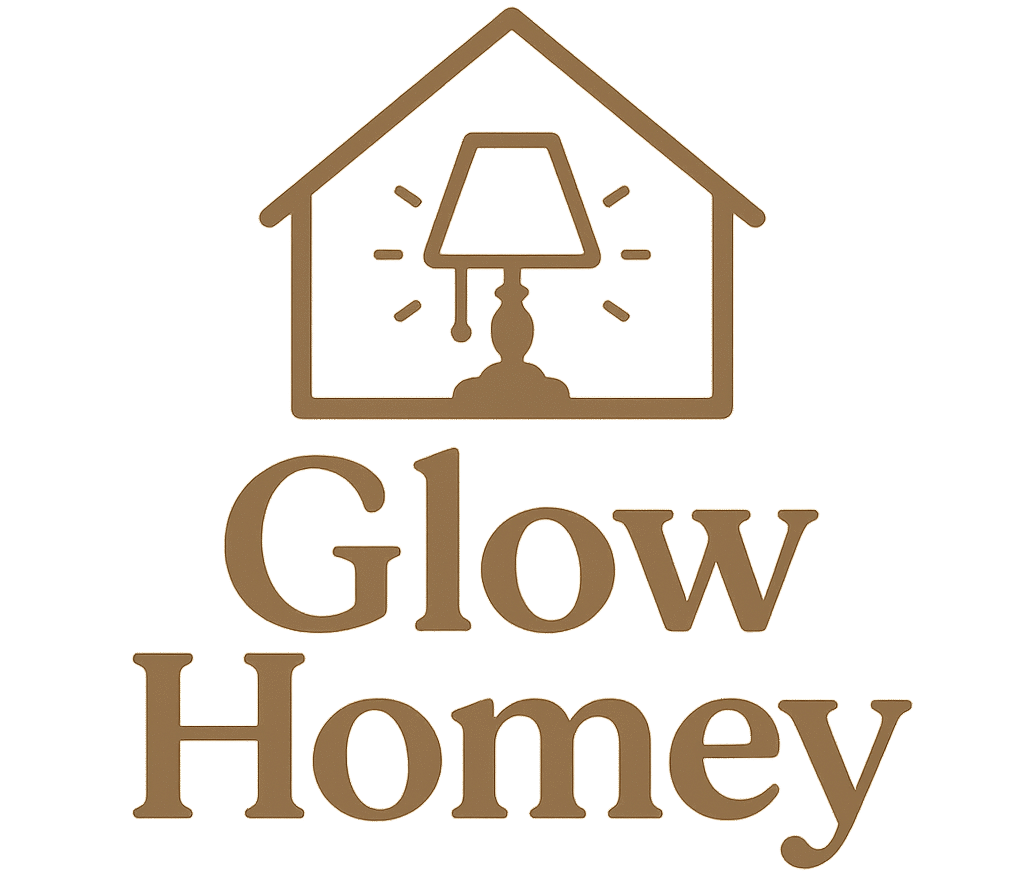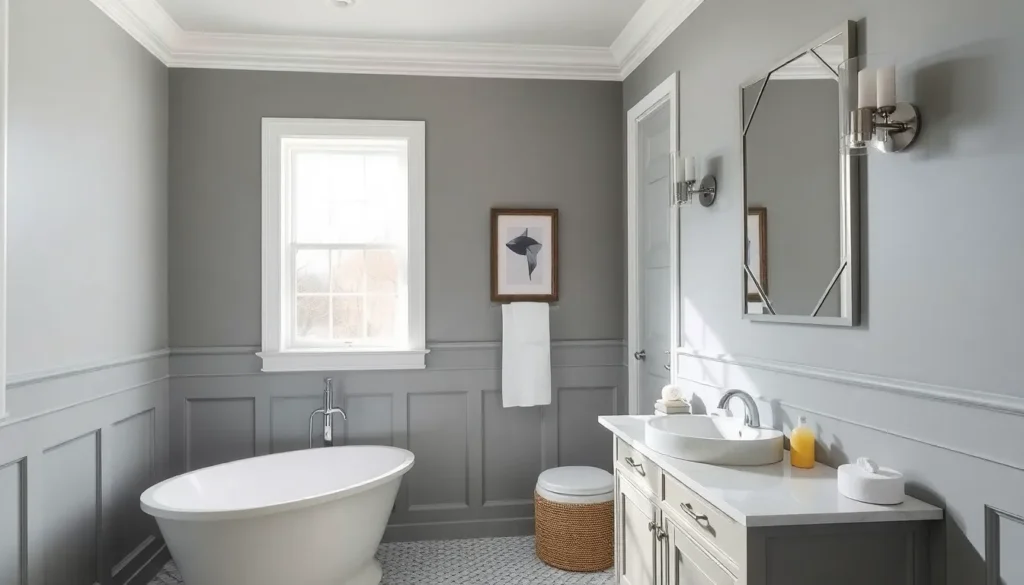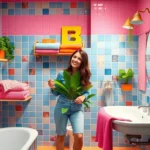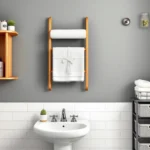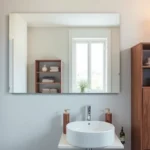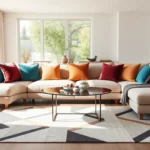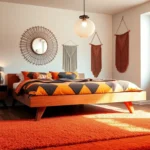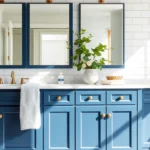Gray has become the ultimate go-to color for bathroom transformations and we’re here to show you why it’s taking over modern home design. This versatile hue offers the perfect balance between timeless elegance and contemporary sophistication that’ll make your bathroom feel like a luxury spa retreat.
Whether you’re working with a cramped powder room or a spacious master bath we’ve discovered that gray paint can completely revolutionize your space. From soft dove grays that create an airy atmosphere to dramatic charcoal tones that add striking depth gray offers endless possibilities for every style preference and budget.
We’ll explore the most stunning gray paint combinations trending right now plus share insider tips on choosing the perfect shade for your lighting conditions and existing fixtures. Get ready to transform your bathroom into a magazine-worthy sanctuary that you’ll never want to leave.
Choose Light Gray Shades for Small Bathrooms
Light gray paint shades work exceptionally well in compact bathrooms by creating an illusion of spaciousness while maintaining sophisticated style. We recommend selecting lighter tones that reflect natural light and complement your existing fixtures.
Dove Gray for Airy Feel
Dove gray creates an open and breathable atmosphere in cramped bathroom spaces. This soft neutral shade features subtle warm undertones that prevent the space from feeling sterile or cold. We’ve found that dove gray pairs beautifully with white trim and chrome fixtures to enhance the airy sensation.
Natural light bounces effortlessly off dove gray walls, making your small bathroom appear larger than its actual dimensions. The gentle hue works particularly well with marble countertops and subway tile backsplashes. Homeowners consistently choose this shade for powder rooms and half baths where space maximization is crucial.
Pearl Gray for Subtle Elegance
Pearl gray delivers refined sophistication without overwhelming small bathroom dimensions. This luminous shade contains hints of silver that catch and reflect light throughout the day. We recommend pearl gray for bathrooms with limited natural light as it brightens the space naturally.
Designer bathrooms frequently showcase pearl gray as the primary wall color because of its versatility with both modern and traditional fixtures. The shade complements brushed nickel hardware and white porcelain beautifully. Accent pieces like towels and artwork pop against pearl gray backgrounds without creating visual clutter.
Cloud Gray for Maximum Brightness
Cloud gray offers the lightest option in the gray paint spectrum while maintaining color depth and interest. This nearly white shade features just enough gray pigment to avoid the stark appearance of pure white walls. We suggest cloud gray for windowless bathrooms or spaces with minimal natural lighting.
Bathroom lighting fixtures cast beautiful shadows on cloud gray walls, creating subtle dimension and texture. The shade works exceptionally well with white subway tiles and creates a seamless flow with white ceilings. Storage answers and bathroom accessories blend effortlessly with cloud gray backgrounds, maintaining the clean minimalist aesthetic that small bathrooms require.
Select Dark Gray Tones for Dramatic Impact

Dark gray paint transforms bathrooms into striking spaces that command attention and exude luxury. These deeper shades create visual depth and serve as the perfect backdrop for high-end fixtures and accessories.
Charcoal Gray for Modern Sophistication
Charcoal gray delivers unmatched elegance with its deep, cool undertones that instantly modernize any bathroom space. This sophisticated shade works exceptionally well when paired with lighter accents like white subway tiles or chrome fixtures to prevent the room from feeling overwhelming. We recommend using charcoal gray on all four walls for a cocoon-like effect, or applying it to the lower half of walls with wainscoting for a balanced approach.
Complement charcoal walls with white or light-colored vanities to create stunning contrast that highlights both elements. Natural light becomes crucial with this dramatic shade, so consider adding mirrors strategically to reflect available light throughout the space. The richness of charcoal gray makes it an ideal choice for powder rooms where bold statements are welcome.
Slate Gray for Industrial Chic
Slate gray captures the essence of industrial design with its cool, dark tone that mimics natural stone surfaces. This versatile shade pairs beautifully with exposed concrete elements, brushed metal fixtures, and minimalist hardware for an authentic industrial aesthetic. We suggest combining slate gray walls with concrete countertops or metal-framed mirrors to enhance the urban loft feeling.
Industrial-style lighting fixtures like Edison bulb sconces or black metal pendants complement slate gray perfectly while adding functional illumination. The color works particularly well in loft bathrooms or modern homes where raw materials and clean lines dominate the design scheme. Consider adding wooden accents like floating shelves to warm up the cool tones of slate gray.
Storm Gray for Bold Statement Walls
Storm gray offers a lighter alternative to charcoal while still delivering dramatic impact in bathroom design. This medium-toned shade works brilliantly as an accent wall behind a floating vanity or bathtub area, creating a focal point without overwhelming smaller spaces. We recommend painting just one wall in storm gray while keeping remaining surfaces in lighter neutral tones for perfect balance.
Textured elements like subway tiles or shiplap paneling enhance storm gray’s visual appeal and add dimensional interest to flat surfaces. The shade transitions beautifully from day to night lighting, appearing slightly different under various conditions while maintaining its sophisticated character. Storm gray coordinates exceptionally well with brass fixtures and natural wood elements for a contemporary yet warm atmosphere.
Create Contrast With Two-Tone Gray Paint Schemes
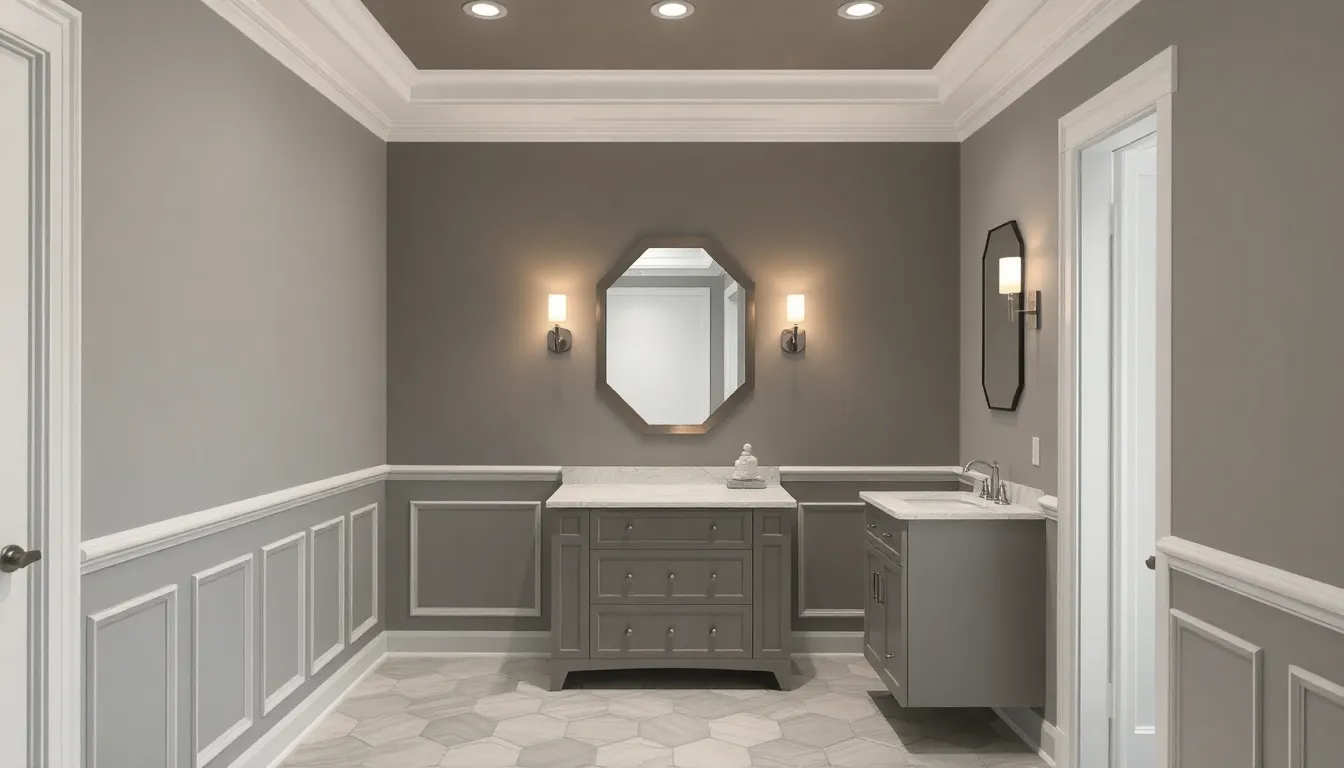
Two-tone gray paint schemes offer the perfect solution for creating visual depth and sophistication in your bathroom space. We’ll explore three effective approaches that transform ordinary bathrooms into stunning retreats.
Light and Dark Gray Combinations
Light and dark gray combinations create visually appealing contrast that enhances your bathroom’s architectural features. We recommend using lighter gray shades on main wall surfaces to maintain that spacious feeling, particularly in smaller bathrooms where every square foot counts.
Darker gray tones work beautifully on trim, baseboards, or lower wall sections to add sophisticated definition. Benjamin Moore’s Charcoal Slate paired with their lighter Smoked Oyster creates an elegant balance that doesn’t overwhelm the space. This strategic color placement draws the eye upward while grounding the room with rich, deeper tones at the foundation level.
Professional designers often apply the 60-30-10 rule when implementing these combinations. The lighter gray covers approximately 60% of the wall space, darker gray accents cover 30%, and white fixtures complete the remaining 10% for perfect visual harmony.
Gray Wainscoting With White Upper Walls
Gray wainscoting paired with white upper walls delivers timeless elegance that works beautifully in both traditional and minimalist bathroom designs. We’ve seen this classic combination transform countless bathrooms by adding architectural interest without sacrificing the clean, airy feel that white provides.
Installation typically extends the gray wainscoting to chair rail height, approximately 36 inches from the floor. Farrow & Ball’s sophisticated gray shades offer exceptional depth and versatility when combined with crisp white upper walls. This approach creates visual weight at the bottom of the room while maintaining brightness above eye level.
White crown molding and trim details enhance the contrast between the gray lower section and white upper walls. The combination works particularly well with traditional white fixtures, creating a cohesive design that feels both fresh and enduring.
Accent Wall in Deeper Gray Shade
Accent walls featuring deeper gray shades serve as striking focal points that add dramatic depth without overwhelming your entire bathroom space. We suggest selecting the wall behind your vanity or the wall opposite the entrance as your accent surface for maximum visual impact.
Benjamin Moore’s Flint or Brushed Aluminum create sophisticated focal points when applied to a single wall while keeping remaining surfaces in lighter tones. This technique works especially well in bathrooms with abundant natural light, where the deeper shade can showcase its richness without making the space feel closed in.
Strategic lighting placement becomes crucial with deeper accent walls. Wall sconces or pendant lights directed at the accent surface highlight the paint’s depth while maintaining adequate illumination throughout the space. The contrast between your deeper accent wall and lighter surrounding surfaces creates visual interest that transforms ordinary bathrooms into designer showcases.
Incorporate Warm Gray Paint Colors for Cozy Atmosphere
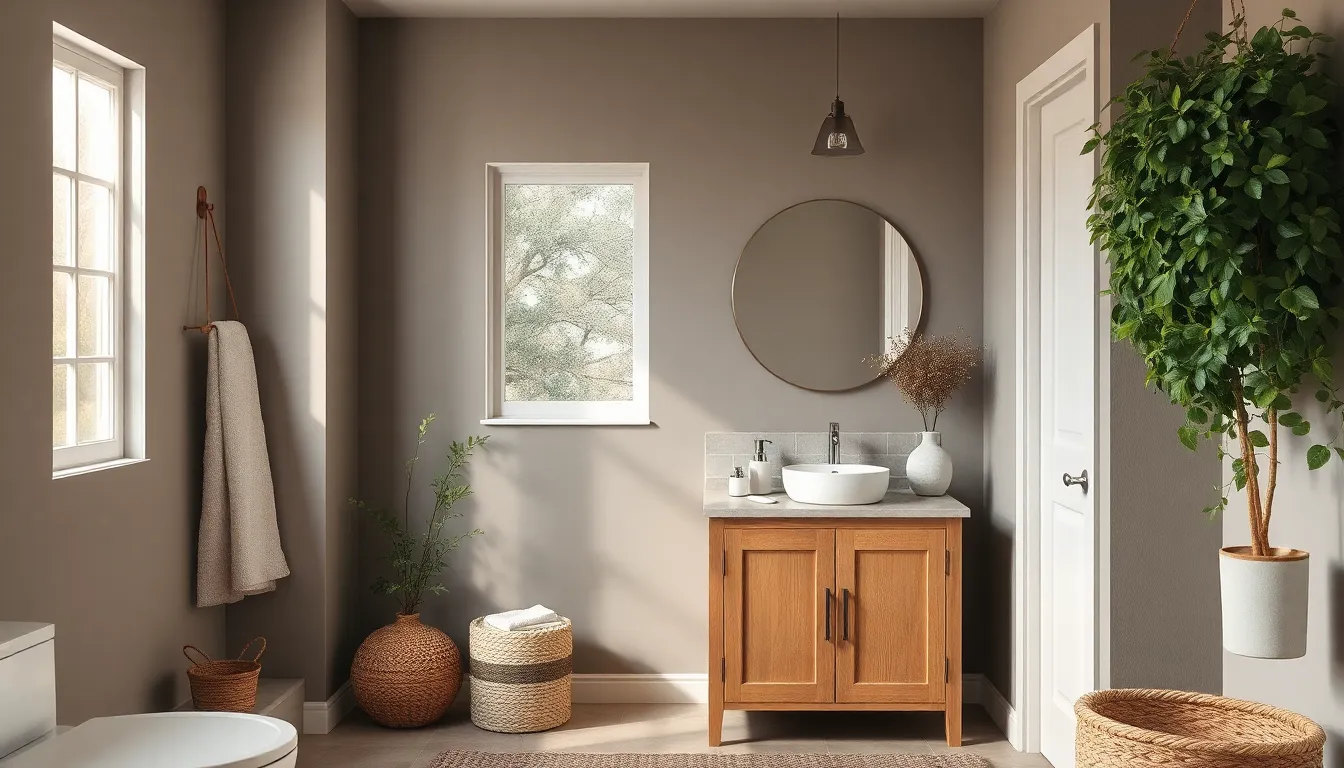
We’ve explored cooler gray tones, but warm gray paint colors transform bathrooms into inviting retreats that feel both sophisticated and comfortable.
Greige Blends for Balanced Warmth
Greige paint creates the perfect balance between gray’s modern appeal and beige’s natural warmth. This versatile blend works beautifully in bathrooms where we want neither too much coolness nor excessive warmth. We can pair greige with various bathroom styles, from traditional farmhouse designs to sleek contemporary spaces.
Benjamin Moore’s warm gray collection offers several greige options that provide a cozy and welcoming environment. These shades serve as soothing backdrops that complement both warm brass fixtures and cool chrome accents. Greige walls work particularly well when we add natural textures like woven baskets or wooden vanities.
Mushroom Gray for Earthy Vibes
Mushroom gray brings earthy undertones that create a natural, spa-like ambiance in our bathrooms. This sophisticated shade pairs beautifully with live greenery and natural wood elements. We love how mushroom gray enhances the organic feel when combined with stone countertops or pebble tile accents.
Plants thrive against mushroom gray walls, making our bathrooms feel like peaceful sanctuaries. This earthy tone works especially well in powder rooms where we want to create a memorable impression. Mushroom gray also complements natural lighting beautifully, shifting subtly throughout the day.
Taupe-Gray Mixtures for Inviting Spaces
Taupe-gray combinations deliver the perfect blend of warmth and neutrality for inviting bathroom spaces. These mixtures work exceptionally well with traditional and rustic decor styles. We recommend taupe-gray for master bathrooms where relaxation is the primary goal.
These balanced shades create sophisticated backdrops that never feel cold or sterile. Taupe-gray walls complement warm metals like brass and gold fixtures beautifully. We can enhance this inviting atmosphere by incorporating natural textures such as jute rugs or wooden storage answers.
Apply Cool Gray Paint Hues for Spa-Like Serenity

Cool gray paint transforms bathrooms into serene retreats that mirror the tranquil atmosphere of professional spas. These refreshing hues reflect light beautifully and create the illusion of expanded space in smaller bathrooms.
Blue-Gray Tones for Calming Effect
Blue-gray tones blend the sophistication of gray with subtle blue undertones that instantly calm the mind and body. Slate gray delivers this peaceful effect while maintaining enough depth to add visual interest to your bathroom walls. Dove gray variations with blue hints work exceptionally well in bathrooms where relaxation takes priority over bold design statements.
We recommend pairing blue-gray walls with white fixtures and soft pastel accents to amplify the calming atmosphere. Chrome faucets and shower heads complement these tones perfectly, creating a cohesive spa-inspired design. Natural light enhances blue-gray paint colors by bringing out their subtle variations throughout the day.
Silver Gray for Clean Modern Look
Silver gray creates a sleek contemporary appearance that defines modern bathroom design with its polished sophistication. This metallic-inspired hue complements chrome finishes, stainless steel fixtures, and glass shower enclosures for a cohesive minimalist aesthetic. Designers frequently choose silver gray because it maintains brightness while adding depth to bathroom spaces.
We find that silver gray works particularly well in bathrooms with limited natural light, as it reflects artificial lighting effectively. Glossy finishes in silver gray enhance the clean, crisp feeling that modern bathrooms demand. Pairing this hue with white trim and black accents creates striking contrast without overwhelming the space.
Sage Gray for Natural Tranquility
Sage gray merges traditional gray with gentle green undertones that bring natural elements into your bathroom sanctuary. This earthy shade creates harmony when paired with wooden vanities, stone countertops, and natural fiber accessories. We’ve observed that sage gray works beautifully in bathrooms that incorporate plants and organic textures.
Stone surfaces like marble or granite complement sage gray walls by reinforcing the natural theme throughout the space. Wooden accents in warm tones enhance the earthy quality of sage gray while maintaining the sophisticated gray foundation. This versatile shade adapts well to both matte and satin finishes, depending on your desired level of subtle elegance.
Pair Gray Paint With Complementary Color Accents

Strategic color pairings transform gray bathrooms from simple to stunning. Let’s explore complementary combinations that enhance gray’s natural versatility.
Gray and White Classic Combinations
Gray and white creates the ultimate timeless combination for bathroom spaces. Traditional white fixtures complement gray walls beautifully, establishing a harmonious and balanced environment that never goes out of style. We recommend using this pairing to achieve a serene and clean aesthetic that works with any decor style.
Crisp white trim against gray walls adds architectural interest without overwhelming the space. Subway tiles in glossy white provide texture while maintaining the classic appeal. White vanities and fixtures brighten the room while allowing gray tones to anchor the design with sophistication.
Gray With Navy Blue Accents
Navy blue introduces dramatic flair when paired with gray paint colors. This bold combination creates visual depth without overwhelming smaller bathroom spaces, making it perfect for homeowners seeking sophisticated contrast. Deep navy towels, shower curtains, or cabinet hardware provide striking focal points against gray walls.
Consider incorporating navy through geometric tiles or painted accent walls for maximum impact. Brass fixtures complement this pairing exceptionally well, adding warmth to the cool color palette. Navy accessories like soap dispensers and storage baskets complete the look while maintaining functionality.
Gray and Blush Pink Soft Contrasts
Blush pink accents add feminine elegance to gray bathroom designs. This combination creates visually appealing contrast that feels both calming and sophisticated, perfect for master bathrooms or powder rooms. Soft pink towels, artwork, or floral arrangements provide gentle warmth against cool gray backgrounds.
Rose gold fixtures enhance this color scheme beautifully, bridging the gap between pink and gray tones. Blush pink ceramics or decorative tiles can serve as subtle accent pieces. This pairing works especially well in bathrooms with abundant natural light, where pink undertones can shine without appearing overwhelming.
Consider Different Gray Paint Finishes for Functionality

Selecting the right gray paint finish is crucial for bathroom durability and maintenance. Different finishes offer varying levels of moisture resistance and cleaning ease that directly impact your bathroom’s longevity.
Satin Finish for Easy Cleaning
Satin finish provides the perfect balance between durability and aesthetics for most bathroom areas. We recommend this finish for general wall surfaces where you need regular cleaning without sacrificing visual appeal. The subtle sheen reflects light gently while resisting moisture and stains better than flat finishes.
Maintenance becomes effortless with satin’s smooth surface that wipes clean with standard bathroom cleaners. Your gray walls maintain their rich color depth while standing up to daily humidity and occasional splashes. This finish works exceptionally well in powder rooms and main bathroom areas away from direct water contact.
Semi-Gloss for High-Moisture Areas
Semi-gloss finish delivers superior water resistance for bathroom zones exposed to heavy moisture. We suggest applying this finish around sinks, showers, and bathtub areas where water splashing occurs regularly. The higher sheen level creates a protective barrier that prevents water penetration and mold growth.
Cleaning becomes virtually effortless as semi-gloss surfaces repel water and soap residue effectively. Your gray paint maintains its integrity even with frequent scrubbing and strong cleaning products. This finish proves ideal for families with children or high-traffic bathrooms requiring frequent deep cleaning.
Eggshell for Subtle Texture
Eggshell finish offers a sophisticated texture while providing better cleanability than flat paint. We recommend this option for accent walls or areas where you want visual interest without high-gloss reflection. The subtle texture adds depth to gray tones while maintaining a refined appearance.
Durability exceeds flat finishes though it requires gentler cleaning methods than satin or semi-gloss options. Your gray walls develop character through the slight texture variation that enhances both warm and cool gray undertones. This finish works beautifully in master bathrooms where elegance takes priority over heavy-duty functionality.
Match Gray Paint to Your Bathroom’s Natural Light

Natural light direction significantly impacts how gray paint appears in your bathroom. We’ll explore how different exposures affect gray tones and guide you toward the most flattering selections.
North-Facing Bathroom Gray Selection
North-facing bathrooms receive minimal, cooler natural light throughout the day. We recommend choosing warm gray tones with beige or taupe undertones to counteract this cooler lighting and prevent your space from feeling cold or unwelcoming.
Greige combinations work exceptionally well in north-facing spaces because they add warmth without sacrificing the sophisticated gray aesthetic. Benjamin Moore’s warm gray collection offers several greige options that maintain their cozy appeal even under cooler northern light.
Mushroom gray creates an earthy foundation that feels naturally warm in these conditions. This shade’s brown undertones help offset the blue cast that northern light can create on cooler grays.
Taupe-gray mixtures provide the perfect balance for north-facing master bathrooms where you want to maintain a relaxing, spa-like atmosphere. These warmer tones foster comfort while preserving the modern elegance that gray delivers.
South-Facing Room Color Choices
South-facing bathrooms benefit from abundant, warm natural light that intensifies paint colors throughout the day. We can confidently use both cool and warm gray tones in these well-lit spaces.
Cool grays maintain their true color under strong southern light and provide a refreshing contrast to the natural warmth. Blue-gray tones particularly excel in south-facing bathrooms, creating that coveted spa-like serenity while the bright light prevents them from feeling cold.
Medium gray shades add richness without overwhelming the space when paired with south-facing windows. Storm gray works beautifully as an all-over color in these conditions, providing visual interest while the natural light keeps the room from feeling closed in.
Silver gray creates sleek sophistication in south-facing bathrooms, especially when the strong light enhances its reflective qualities. This shade complements chrome fixtures and maintains its modern appeal under varying light conditions throughout the day.
Artificial Lighting Considerations
Artificial lighting dramatically alters how gray paint appears, making it essential to test your selections under actual bathroom lighting conditions. We strongly recommend evaluating paint samples at different times of day to ensure consistent appeal.
Warm bulbs make cool grays appear muddy because the yellow tones conflict with blue or green undertones in the paint. If you’re using warm artificial lighting, stick with warmer gray selections like greige or taupe-gray mixtures.
Cool LED bulbs intensify cooler gray hues, which can work beautifully if that’s your desired effect. But, these same bulbs can make warm grays appear flat or washed out under certain conditions.
Testing under combined lighting reveals the truth about how your chosen gray will perform throughout the day. Paint large sample patches and observe them under natural light, warm artificial light, and cool artificial light to make the most well-informed choice.
Dimmer switches provide flexibility for adjusting how your gray paint appears during different activities. We recommend installing dimmers to control the intensity and warmth of your artificial lighting, allowing you to showcase your gray selection at its best.
Conclusion
We’ve explored the incredible versatility of gray paint in bathroom design showing how this sophisticated color can transform any space into a luxurious retreat. From light dove grays that brighten small bathrooms to dramatic charcoal tones that create modern elegance gray offers endless possibilities for every style and budget.
The key to success lies in understanding how lighting affects gray paint and choosing the right finish for durability and maintenance. Whether you opt for warm greige tones or cool blue-grays remember that testing samples in your exact lighting conditions ensures the perfect result.
Gray paint continues to prove itself as the ultimate choice for bathroom renovations delivering both timeless appeal and contemporary sophistication that will enhance your home’s value for years to come.
Frequently Asked Questions
What makes gray paint a good choice for bathroom renovations?
Gray paint offers a perfect blend of timeless elegance and modern sophistication. It works well in both small and large bathrooms, creating a luxurious retreat feel. Gray comes in various shades from light dove gray to deep charcoal, making it versatile for different styles and budgets while providing a sophisticated alternative to traditional white.
Which gray shades work best for small bathrooms?
Light gray shades are ideal for small bathrooms as they create an illusion of spaciousness. Dove gray reflects natural light beautifully, pearl gray brightens spaces with limited light, and cloud gray is perfect for windowless bathrooms. These lighter tones maintain sophistication while making the space feel larger and more open.
Can I use dark gray paint in my bathroom?
Yes, darker gray tones like charcoal, slate, and storm gray can create dramatic, modern sophistication. Use them strategically with lighter accents to prevent overwhelming the space. Consider applying dark gray to accent walls or combining with wainscoting. Ensure adequate natural light and strategic lighting to maximize their appeal.
What are two-tone gray paint schemes?
Two-tone gray schemes use different gray shades to create visual depth and sophistication. Apply lighter grays on main walls and darker tones on trim or lower sections. Follow the 60-30-10 rule for visual harmony. Gray wainscoting with white upper walls is a classic example that adds architectural interest.
What’s the difference between warm and cool gray paints?
Warm grays contain beige or brown undertones (like greige and mushroom gray), creating inviting, spa-like retreats. Cool grays have blue or green undertones (like blue-gray and silver gray), evoking serene, modern aesthetics. Choose based on your desired atmosphere and existing fixtures.
How do I choose complementary colors for gray bathroom paint?
Classic combinations include gray with crisp white trim for timeless elegance, navy blue accents for dramatic sophistication, and blush pink for feminine warmth. White fixtures and subway tiles work universally, while navy geometric tiles and rose gold fixtures add contemporary flair to gray schemes.
What paint finish should I use for gray bathroom walls?
Satin finish offers the best balance of durability and aesthetics for general wall surfaces. Use semi-gloss in high-moisture areas for superior water resistance and easy cleaning. Eggshell finish works well for accent walls, providing sophisticated texture with better cleanability than flat paint.
How does natural light affect gray paint appearance?
Natural light direction significantly impacts how gray paint looks. North-facing bathrooms benefit from warm gray tones to counteract cooler lighting, while south-facing spaces work well with cool grays. Always test paint samples under various lighting conditions, including artificial light, before making your final decision.
Should I test gray paint samples before committing?
Absolutely. Gray paint can look dramatically different under various lighting conditions throughout the day. Test samples on different walls and observe them in natural light, artificial light, and at different times. This ensures your chosen gray maintains its appeal and meets your expectations in your specific bathroom environment.
Can gray paint work with existing bathroom fixtures?
Yes, gray is highly versatile and complements most fixture finishes. Warm grays pair well with brass and gold fixtures, while cool grays complement chrome and stainless steel. The neutral nature of gray makes it adaptable to existing elements, often eliminating the need for costly fixture replacements during renovation.
